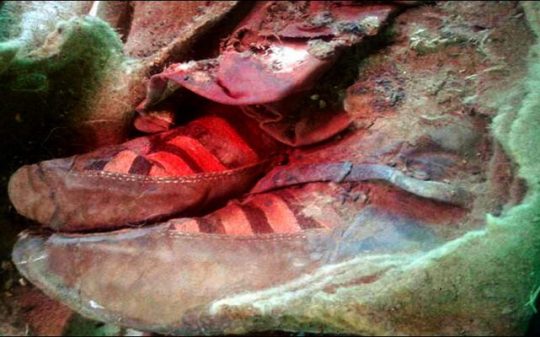Tap the bell for notifications!
A recently unearthed mummy equipped with a well-preserved pair of ‘Adidas sneaker’ has intrigued archaeologists and conspiracy theorists alike. While some consider it to be only a lucky find, others have brought conclusive arguments as to why this could be the remnants of an actual time traveler.
Time travel has always been a fascinating topic, especially in present days when this concept doesn’t look so futuristic after all. With our current development in technology, we can dream of cruising through time in a couple hundred years. Until that day arrives, we’ll need to focus our attention on a very bizarre archaeological find from the Altai Mountains in Siberia, where an unusual mummy had recently been discovered.
So, what’s the connection between those mummified remains and time travel? Well, there’s a certain item on the deceased body that’s strongly resembling a pair of – you guessed it – Adidas sneakers. If the pair of shoes prove to be authentic, then the world will know that time travel is a real phenomenon. However, I’m inclined to think that people at that time were only skilled shoemakers. Or were they really?
The extremely well-preserved remains belong to a Turkik person that lived some 1,500 years ago in central Asia. The body was found alongside the remains of a horse, a pillow, and a sheep’s head. Archaeologists also found a saddle, bridle, clay vase, wooden bowl, trough, iron kettle, and four different ‘Dool’ (Mongolian clothes).
“It is the first complete Turkik burial at least in Mongolia – and probably in all Central Asia. This is a very rare phenomenon. These finds show us the beliefs and rituals of Turkiks,” said B. Sukhbaatar, researcher at Khovd Museum. “We can see clearly that the horse was deliberately sacrificed. It was a mare, between four and eight years old. Four coats we found were made of cotton.”
Researchers haven’t been able to determine the genre of the deceased so far, but they believe the remains belonged to a woman because they found no trace of a weapon inside the tomb, where male warriors were always buried alongside their bow.
The resting place was found at an altitude of 2,803 meters, and the mummy – still wrapped in felt – was resting its bones inside a 3-metre-deep grave. The body preserved extremely well because of the cold temperatures, together with the belongings and horse remains.
“The grave was located 2803 meters above sea level.This fact and the cool temperatures helped to preserve the grave,” said Sukhbaatar. “The grave was three meters deep. The finds show us that these people were very skilled craftsmen. Given that this was the grave of a simple person, we understand that craft skills were rather well developed.”
There are several things that don’t add up here. First of all, Mongolians are well-known for their herds of horses, which in turn determines the wealth of their people. These noble animals were (and still are) essential to them, meaning that whenever someone died, they would leave behind a substantial herd.
The grave of the Turkik mummy is considered to be rich in possessions, but since only the remains of a horse were found inside, researchers are now insinuating that the mummy didn’t belong to the elitist class of the region. But how is that possible if four different garbs, together with a presumed pair of ‘Adidas sneakers’ and numerous other items including the wool originating from a camel were discovered inside the tomb? Could it be that this woman was of a different culture? A distant traveler with knowledge of time manipulation?
A Romanian archaeologist explains more about the burial ceremony in his book about Turkik nomads. It reveals that Turkik people preferred being buried with far less material possessions, but they sacrificed their horses to accompany them on the other side.
“When a man died, the survivors dug a pit as large as a house, in which they laid the deceased holding in his hand a wooden cup filled with a drink, as well as his belt, bow, and money…Following that, the dead man’s horses were killed, the number of horses sacrificed being an indication of his personal wealth.”
So how does a not-so-wealthy Turk woman end up in a strategically-placed grave atop of the Altai Mountains, together with rich possessions and a pair of sneakers from the future? Is it possible that archaeologists really stumbled across the mummified remains of a time traveler, or is this but a mere coincidence?
More images from inside the tomb can be found HERE.










